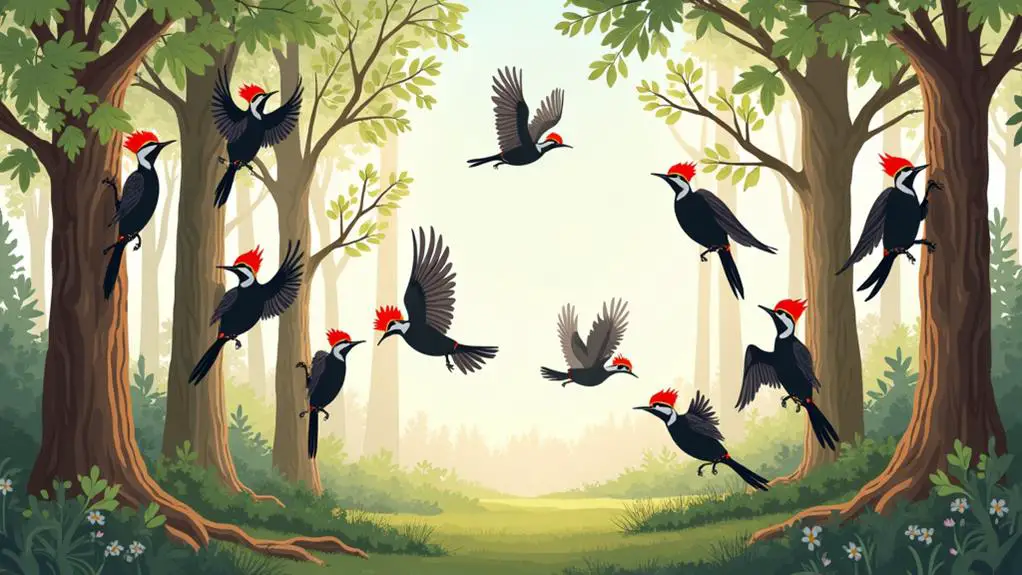You're likely familiar with the woodpeckers that visit your backyard in Illinois, but did you know there are 10 species to look out for? Some, like the Downy Woodpecker and Hairy Woodpecker, are regular visitors, while others, such as the Red-headed Woodpecker and Pileated Woodpecker, are less common. Each of these species has unique characteristics that set them apart, from striking plumage patterns to distinct calls. As you explore the world of Illinois woodpeckers, you'll discover the fascinating differences between them – but first, let's take a closer look at what makes each species special.
Key Takeaways
- Illinois is home to 10 woodpecker species, including the Downy, Hairy, Red-headed, Pileated, Northern Flicker, Red-bellied, Yellow-bellied Sapsucker, American, Black-backed, and others.
- The Downy Woodpecker is the most common and widespread species in Illinois, with a distinctive black and white striped back and white underside.
- The Pileated Woodpecker is found in mature forests with large trees, particularly those dominated by deciduous species, and is known for its bright red crest.
- The Red-headed Woodpecker is a partial migrant, with some populations migrating south for the winter, and is found in open areas with scattered trees.
- Woodpeckers in Illinois can be identified by their unique plumage patterns, beak shapes, and drumming patterns, which serve as a form of communication and territorial defense.
Downy Woodpecker

Perched on a tree trunk, you'll often spot the Downy Woodpecker, a common and widespread species in Illinois.
This woodpecker's small size, black and white striped back, and white underside make it easily identifiable. The Downy Woodpecker's diet consists mainly of insects, including beetles, ants, and caterpillars, which it extracts from tree bark using its long, pointed beak.
It also consumes sap, particularly in the winter when insects are scarce.
In addition to its distinctive appearance and diet, the Downy Woodpecker is known for its unique drumming patterns.
Drumming serves as a form of communication and territorial defense, with the Downy Woodpecker typically drumming on dead trees or branches.
The drumming pattern consists of a series of rapid, high-pitched beats, often followed by a slower, more deliberate beat.
This pattern can be used to distinguish the Downy Woodpecker from other woodpecker species.
Hairy Woodpecker
When you encounter a Hairy Woodpecker in Illinois, you'll notice its key identification features, including a black and white striped back, white outer tail feathers, and a long, chisel-shaped bill.
You'll typically find this species in mature woodlands with large trees, where it can meet its woodland habitat requirements.
Key Identification Features
Among Illinois' woodpeckers, the Hairy Woodpecker is readily identified by its size and distinctive plumage patterns.
As you observe this bird, note that it measures between 7-10 inches in length, making it a medium-sized woodpecker. Its back and wings display a black and white striped pattern, while its underside is predominantly white.
When distinguishing the Hairy Woodpecker from other species, consider the following key identification features:
- Beak shape variations: The Hairy Woodpecker has a long, chisel-shaped beak that's well-suited for excavating insects from tree bark.
- Feather pattern differences: The white underside of the Hairy Woodpecker is unmarked, while its black back and wings display a distinctive white spotting pattern.
- Red cap: Males have a bright red cap on the back of their heads, while females have a black cap with white stripes.
Woodland Habitat Requirements
Woodland habitat requirements are a critical component in understanding the ecological needs of the Hairy Woodpecker, given that this bird's distribution is often dictated by the availability of suitable woodlands.
When evaluating woodland habitats for Hairy Woodpeckers, you should consider the forest structure, as they tend to prefer areas with a mix of deciduous and coniferous trees.
The ideal forest structure typically consists of a diverse array of tree species, with varying ages and diameters.
Tree density is another crucial factor, as Hairy Woodpeckers typically require woodlands with a moderate to high tree density.
This allows them to forage for insects and sap more efficiently, while also providing adequate cover and nesting sites.
You'll often find Hairy Woodpeckers in woodlands with a canopy cover of 60-80%, which provides the necessary shade and shelter.
In terms of tree diameter, they tend to prefer trees with diameters ranging from 10-30 cm, as these provide the optimal substrate for foraging and nesting.
Red-headed Woodpecker
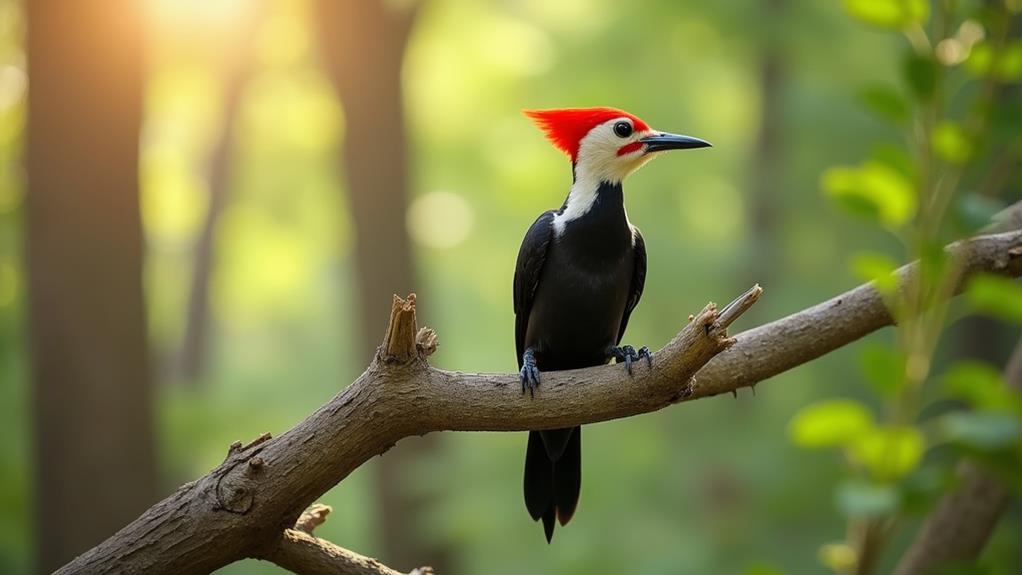
Observing the Red-headed Woodpecker's distinctive plumage is crucial for identification, as it features a vibrant red cap that covers its entire head, contrasting sharply with its black back and white wings.
This striking coloration makes it one of the most recognizable woodpeckers in Illinois. When you're trying to spot a Red-headed Woodpecker, look for open areas with scattered trees, as they tend to forage for insects and sap in these environments.
To better understand the behavior of Red-headed Woodpeckers, consider the following key points:
- Nesting habits: Red-headed Woodpeckers excavate their own nests in dead trees or branches, often reusing existing cavities. They typically raise 2-5 young per breeding season.
- Migration patterns: Red-headed Woodpeckers are partial migrants, with some populations migrating south for the winter while others remain in their year-round territories.
- Diet: These woodpeckers primarily feed on insects, fruits, and nuts, playing an essential role in controlling pest populations and dispersing seeds in their ecosystems.
Pileated Woodpecker
When you encounter the Pileated Woodpecker in Illinois, you'll likely find it in mature forests with large trees, particularly those dominated by deciduous species like oak and beech.
The species' distribution throughout the state is widespread, although it tends to favor areas with minimal human disturbance.
As you examine the Pileated Woodpecker, you'll notice its distinctive physical characteristics, including a bright red crest and a large, chisel-shaped bill.
Habitat and Distribution
In search of suitable habitat, you'll likely find the Pileated Woodpecker in mature forests with an abundance of large, dead, or dying trees.
These forests typically have a complex structure, with a mix of deciduous and coniferous tree species. The presence of large trees is crucial, as they provide the necessary cavities for nesting and foraging.
However, the fragmentation of these forests can have a negative impact on Pileated Woodpecker populations, as it reduces the availability of suitable habitat and increases the effects of edge habitats.
Forest fragmentation and edge effects play a significant role in shaping the Pileated Woodpecker's habitat and distribution.
Some key factors to consider include:
- Forest patch size and shape, which can influence the availability of resources and the level of fragmentation
- Edge density, which can affect the amount of habitat available and the level of disturbance
- Connectivity between forest patches, which is crucial for maintaining healthy populations and allowing for movement and dispersal
In Illinois, the Pileated Woodpecker can be found in the southern and western parts of the state, where mature forests are more abundant.
They tend to avoid urbanized areas and instead opt for more remote, forested regions.
Physical Characteristics
Characterized by their distinctive red crest and black-and-white striped face, Pileated Woodpeckers are the largest woodpeckers in North America. You'll notice the bird's red crest is more prominent in males, while females have a black stripe above their beak and a red stripe on the back of their head.
When observing Pileated Woodpeckers, you'll see notable beak shape differences and plumage pattern variations. These variations can be key in distinguishing between males and females, as well as between Pileated Woodpeckers and other woodpecker species.
| Characteristic | Description |
|---|---|
| Beak shape | Long, chisel-shaped, and black |
| Plumage pattern | Black back, white underside, and red crest |
| Head pattern | Black-and-white striped face, with a red stripe on the back of the head in females |
| Size | 16-19 inches in length, with a wingspan of 26-30 inches |
Northern Flicker
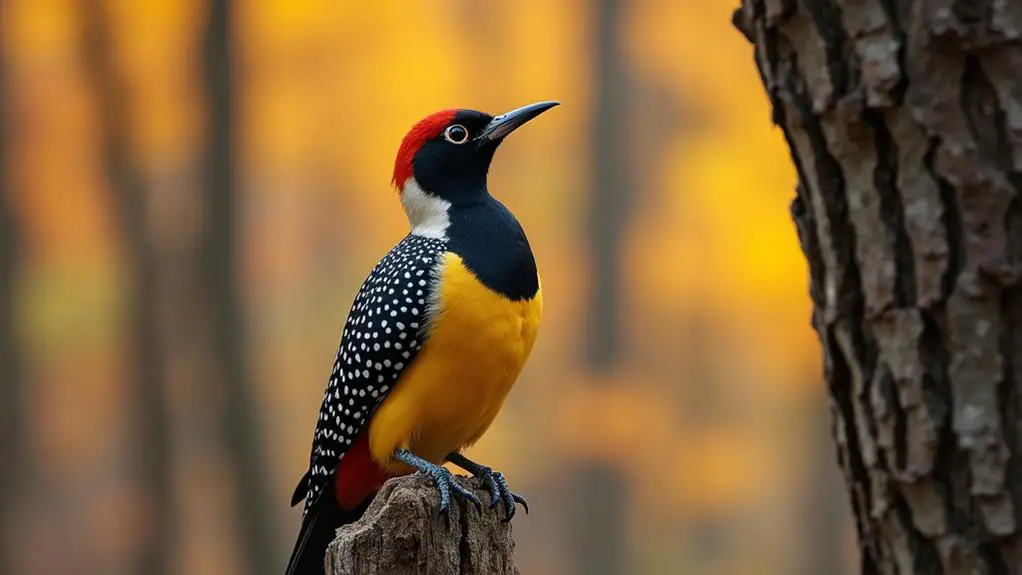
Northern Flickers are medium-sized woodpeckers that breed statewide in Illinois, with year-round populations concentrated in the southern and central regions.
You can identify them by their brown backs, white undersides, and distinctive yellow or red shafts on their tail feathers.
When observing Northern Flickers, you'll notice their unique behaviors and characteristics.
Some key points to consider include:
- Vocalizations: Northern Flickers make a variety of sounds, including loud, piercing calls that can be heard during the breeding season.
- Migration patterns: Northern Flickers are partial migrants, meaning some populations migrate while others remain in their year-round habitats.
- Foraging habits: Northern Flickers primarily forage for insects on or near the ground, using their strong, chisel-like beaks to dig into tree bark and other surfaces.
Note: The original text had a few sentences that were merged together. I've split them into separate paragraphs for better readability.
Red-bellied Woodpecker
You'll find the Red-bellied Woodpecker to be a common year-round resident in Illinois, with populations concentrated in the southern and central regions of the state.
As a mid-sized woodpecker, it measures approximately 9-10 inches in length and has a wingspan of around 15-16 inches. It's recognizable by its red cap and white undersides with black-and-white striped backs. The male and female differ slightly, as the male's cap is fully red, while the female's cap is black with red only on the nape of the neck.
Red-bellied Woodpeckers are cavity-nesting birds that often excavate their own nests or use existing cavities in trees or power poles.
The nesting habits typically begin in late March to early May, and both males and females take turns incubating eggs.
In terms of foraging behavior, they're adaptable birds that can be found in various woodlands and backyards, particularly where food is readily available.
Their foraging techniques involve extracting insects, seeds, and fruits from tree bark and leaves using their long, pointed bills and chisel-like beaks.
Their feeding behaviors can be quite dynamic, shifting from bark to aerial hawking of insects and back again throughout the year.
Yellow-bellied Sapsucker
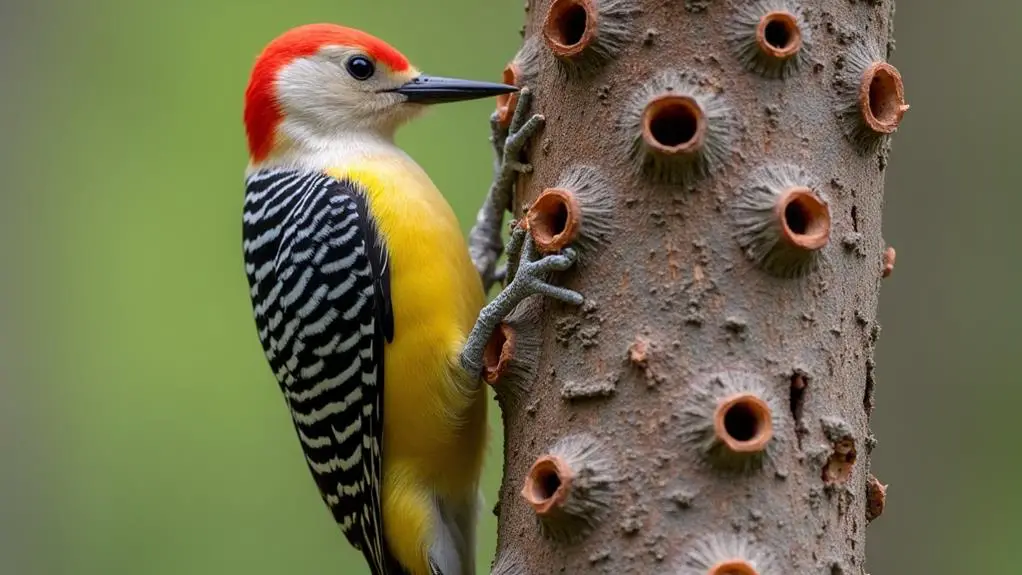
As you observe the Yellow-bellied Sapsucker, you'll notice its medium size, typically 7-8.5 inches in length, with a black and white striped back, white underside, and a distinctive yellow belly.
You'll also see a red cap on top of its head, which distinguishes males from females.
In terms of breeding habits, you'll find that Yellow-bellied Sapsuckers typically form monogamous pairs and breed in the spring, with females laying 2-5 eggs in nesting cavities excavated in trees.
Physical Characteristics
When identifying a Yellow-bellied Sapsucker, its medium size, typically around 7-8 inches in length, is a distinguishing feature.
This medium size is accompanied by a wingspan of around 13-15 inches, which helps you to identify it from other woodpeckers in Illinois. You'll also notice that the Yellow-bellied Sapsucker has a relatively long, square-shaped tail and short legs.
In terms of beak adaptations, the Yellow-bellied Sapsucker's chisel-shaped beak is perfect for drilling into trees.
This adaptation allows it to excavate sap wells and insects with ease.
- Red crown and white stripes on the head, which distinguish it from other woodpeckers
- Yellowish belly and white underside, with a black and white striped back
- White wing patches, visible during flight
Its distinctive feather patterns, including the red crown and white stripes on the head, make the Yellow-bellied Sapsucker a striking bird.
Pay attention to these markings, as they'll help you identify the bird during your birdwatching excursions in Illinois.
Breeding Habits
Breeding season for the Yellow-bellied Sapsucker typically occurs from April to July, with the peak breeding period happening in May.
As you observe the species' breeding habits, you'll notice that males establish territories and engage in mate selection strategies to attract females. They'll often drum on trees to advertise their presence and suitability as a mate.
You'll also witness courtship display behaviors, such as the "drumming display," where the male drums on a tree in a specific pattern to signal his identity and quality.
During courtship, the male will also perform a "display flight," where he'll fly between trees, making a distinctive "nasal" call. This display serves to reinforce his dominance and attract a female.
Once a pair forms, they'll work together to excavate a nesting cavity, typically in a dead or dying tree. The female will lay 2-5 eggs, which both parents will incubate for about 10-14 days.
After the eggs hatch, the parents will take turns feeding and caring for the young, which will leave the nest after about 24-27 days.
American Woodpecker
The American Woodpecker, a medium-sized woodpecker species, is characterized by its distinctive red cap and black-and-white striped back.
As you observe this species, notice its loud, clear drumming sounds, which serve as a primary form of communication.
American Woodpeckers also produce a variety of calls, including a sharp "peek" or "pik" sound, often used to signal alarm or contact with other woodpeckers.
When identifying American Woodpeckers, consider the following key characteristics:
- A medium-sized woodpecker, typically measuring 7-8 inches in length
- A distinctive red cap on the back of the head, with a black-and-white striped back and white underside
- A black stripe above the beak, extending from the forehead to the nape of the neck
As a woodpecker species, American Woodpeckers have natural predators in Illinois, including hawks, owls, and snakes.
These birds have evolved various adaptations to avoid predators, such as their camouflage plumage and ability to freeze in place when threatened.
Black-backed Woodpecker
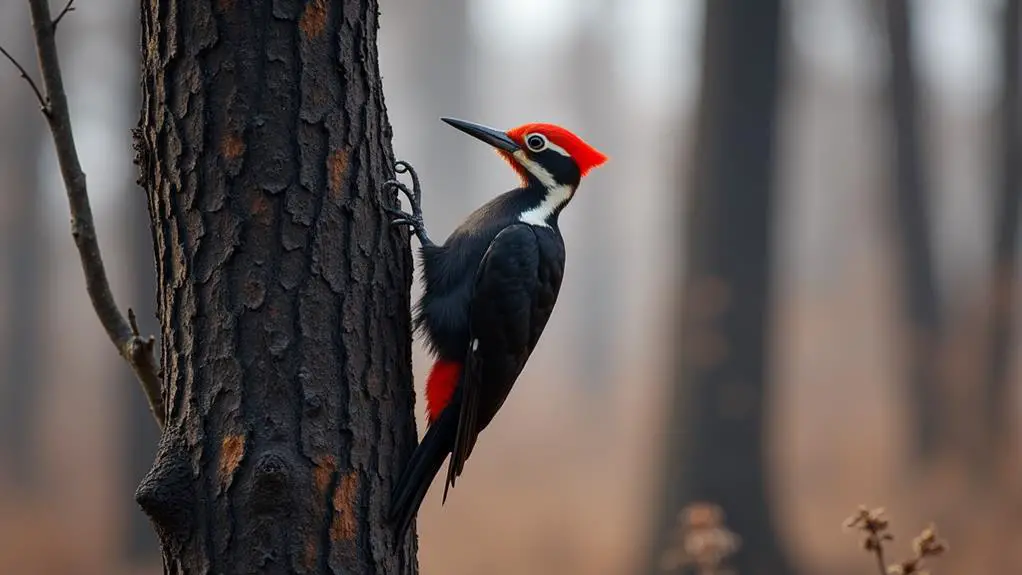
Now that you're familiar with the medium-sized woodpeckers found in Illinois, you may also encounter the Black-backed Woodpecker, a unique species known for its distinct markings.
This woodpecker is a medium-sized bird, measuring approximately 9-10 inches in length, with a black back, white underside, and a distinctive black stripe running from the back of its head to its shoulders.
As forest dwellers, Black-backed Woodpeckers inhabit coniferous forests, particularly those with dead or dying trees.
They're skilled tree excavators, using their strong, chisel-like beaks to extract insects and sap from the bark.
Their excavations often create cavities that can be used by other birds and animals for nesting or roosting.
In Illinois, Black-backed Woodpeckers are typically found in the northern and central regions, where coniferous forests are more prevalent.
They're non-migratory birds, remaining in their territories year-round.
If you're birding in these areas, keep an eye out for the Black-backed Woodpecker's distinctive black and white plumage, and listen for its sharp, drumming calls.
Common Woodpeckers
While exploring Illinois' woodlands, you may encounter several common woodpecker species that play a vital role in the ecosystem.
The most common species in the state include the Downy Woodpecker, Hairy Woodpecker, and Red-headed Woodpecker.
These birds can be identified by their distinctive woodpecker calls, which serve as a form of communication and territorial defense.
- The Downy Woodpecker's call is a high-pitched "pik" or "pick" sound, often repeated in a series of 2-5 notes.
- The Hairy Woodpecker's call is a louder, more nasal "keek" or "kik" sound, often repeated in a series of 2-3 notes.
- The Red-headed Woodpecker's call is a loud, shrill "keer" or "kree" sound, often repeated in a series of 2-5 notes.
These woodpeckers also play a crucial role in creating tree cavities, which provide habitat for a variety of other species.
By excavating cavities for nesting and roosting, woodpeckers create a network of tree holes that can be used by other birds, mammals, and insects.
As a result, woodpeckers are considered a "keystone species" in Illinois' woodlands, and their presence is essential for maintaining the balance of the ecosystem.
Frequently Asked Questions
Can You Mimic the Woodpeckers Drumming Noise Exactly?
You can't perfectly mimic the woodpeckers' drumming noise, as their techniques involve rapid, forceful strikes using their skull's spongy tissue, presenting significant mimicry challenges for humans, who lack such unique physiological adaptations and bone structures.
Why Woodpeckers Not Get Headaches Pecking Trees?
You might wonder why woodpeckers don't get headaches from pecking trees. It's due to their unique skull structure, which includes a spongy, porous bone that provides shock absorption, distributing the force of each peck.
Can Woodpeckers Damage House Siding and Trim?
You might notice woodpeckers causing siding damage due to their pecking patterns, which can create holes and gaps in exterior materials like vinyl, stucco, or wood, especially during breeding or foraging activities.
Do Woodpeckers Eat Insects Only for Food?
You'll find that 75% of a woodpecker's diet consists of insects, but they don't eat insects only. Their food sources also include sap, nuts, and fruits, which contribute to their overall nutrient intake and energy needs.
Are Woodpeckers Endangered Species in Illinois?
You're inquiring about the conservation status of woodpeckers in Illinois. Due to habitat loss and population decline, some Illinois woodpeckers face threats, with species like the Red-headed Woodpecker listed as Endangered or Near Threatened in the state.
Conclusion
You've now familiarized yourself with the 10 woodpecker species in Illinois, each with unique characteristics and habits. To apply this knowledge, consider a scenario where you're walking through a forest and spot a medium-sized woodpecker with a red cap and black-and-white striped back. By recalling the distinct traits of Illinois' woodpeckers, you can confidently identify this bird as a Red-headed Woodpecker, showcasing the importance of understanding these species' differences.

